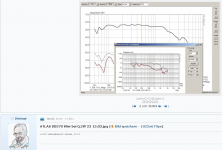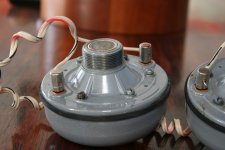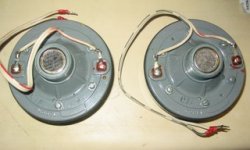Pano. you can use it to produce a mold or to mold directly. That is up to the end use, but I have used these types of patterns to do both.
Pano, It is a way to make a lofted pattern that is as good as you do the detailing. For some of these bass horns and high horns people are talking about it would work well for a fiberglass horn lens.
" The Federal Signal FS100 (now obsolete) was an entire siren speaker, not
just the driver. However, the FS100 used a driver nearly identical to the
SD370 - theirs was manufactured by Korean company Sammi Sound.
The Federal Signal FS100 driver is very similar to the Atlas Sound
(obsolete) SD370 driver
The Atlas Sound AS100N driver is very similar to the current Federal TS100-N
driver - both being thinner and using a Neodymium motor assembly while the
former SD370 and FS100 driver used an AlNiCo motor assembly.
In summary: All four drivers are essentially electronically very similar,
just the newer versions use modern technologies and rare earth magnets
(Neodymium) thus are smaller and lighter, an advantage when used in a
vehicular application where space is a premium."
What does it mean that they are an entire siren speaker, not just the driver? It can still be hooked up and used as a speaker, right?
Also, I think nd compression drivers have a detailed but intense sound to them, compared to more laid back ferrite magnet compression drivers in similar size, but not sensitivity.
Last edited:
Pano, It is a way to make a lofted pattern that is as good as you do the detailing. For some of these bass horns and high horns people are talking about it would work well for a fiberglass horn lens.
I hate working with these toxic plastics and itchy glass fibers.
Last edited:
What does it mean that they are an entire siren speaker, not just the driver? It can still be hooked up and used as a speaker, right?
Also, I think nd compression drivers have a detailed but intense sound to them, compared to more laid back ferrite magnet compression drivers in similar size, but not sensitivity.
They were sold as a complete unit with a siren attached.
Okay, I thought there was some kind of 12V siren tone generator or something inside of them, and I was afraid it would not have normal speaker inputs. Siren signals would be fun for a few seconds but not all the time.
How would that horn look like? As in a straight horn?
I guess something like this:
Throat: 2.05mm
Mouth: 150mm
Depth: 300mm
I really need to learn hornresp soon.
I guess something like this:
Throat: 2.05mm
Mouth: 150mm
Depth: 300mm
I really need to learn hornresp soon.
Last edited:
Inspiration for proper basshorns for the ATLAS drivers:
GoodSoundClub - Romy the Cat's Audio Site - Fiber horn...
Gromt basshorn?
Experience Music, Inc - Goto Double Compression Driver Basshorn...
GoodSoundClub - Romy the Cat's Audio Site - Women and Bass Horns.
GoodSoundClub - Romy the Cat's Audio Site - Fiber horn...
Gromt basshorn?
Experience Music, Inc - Goto Double Compression Driver Basshorn...
GoodSoundClub - Romy the Cat's Audio Site - Women and Bass Horns.
Wouldn't those dimensions need to be in centimeters, not millimeters?I guess something like this:
Throat: 2.05mm
Mouth: 150mm
Depth: 300mm
Ofc! My mistake.
I guess something like this:
Throat: 2.05cm
Mouth: 150cm
Depth: 300cm
I am just guessing about the dimensions. Anyone have a better suggestion for a 80Hz compression driver horn?
I guess something like this:
Throat: 2.05cm
Mouth: 150cm
Depth: 300cm
I am just guessing about the dimensions. Anyone have a better suggestion for a 80Hz compression driver horn?
That's about the mouth opening of the W.E. 15A, both you length is much shorter.
Like you, I'd love to see what Hornresp says.
Like you, I'd love to see what Hornresp says.
I am thinking of a 50Hz Le Cléac'h horn, probably 4 sided and terminating at 90 degrees.
I am currently building a 15Hz Le Cléac'h concrete Bass horn to accommodate a 18" driver for ULF duty.
I am currently building a 15Hz Le Cléac'h concrete Bass horn to accommodate a 18" driver for ULF duty.
The neodymium versions will be more pricey and they will have a smaller back chamber, so may require more mod work?
Interesting double half roll surround on that "370"...
What were the mods to the 370??
Interesting double half roll surround on that "370"...
What were the mods to the 370??
Between 100-500Hz wavelengths are 343-68.6 cm long, according to this calculator: Wavelength frequency convert lambda Hz sound conversion acoustics acoustic audio radio speed of sound and radio typical waves wave length light vacuum equation formula for frequency speed of light color spectrum - sengpielaudio Sengpiel Berlin
I looked this up to get an image of how tight the tolerances have to be for a 100-500Hz horn. My guess is that in the beginning of the throat a horn must be very exact, but closer to the mouth the tolerances can vary several cm and it does not make much difference.
Any thoughts and experiences on this?
I looked this up to get an image of how tight the tolerances have to be for a 100-500Hz horn. My guess is that in the beginning of the throat a horn must be very exact, but closer to the mouth the tolerances can vary several cm and it does not make much difference.
Any thoughts and experiences on this?
Ofc! My mistake.
I guess something like this:
Throat: 2.05cm
Mouth: 150cm
Depth: 300cm
I am just guessing about the dimensions. Anyone have a better suggestion for a 80Hz compression driver horn?
Throat must be 18mm corresponding to the inner diameter of the SD-370s exit.
I measured the K55-V to have a 2.05 mm thoat and assumed Atlas would use the same for all their drivers.
At least that is what I could see through the metal protection mesh. Maybe there is another edge under the grill that I did not see. To me it seem like the throat is the width of the metal mesh. I don't want to open them if the diaphragm is not autoadjusting, but I guess after 40 years I should clean them out. Romy the Cat seem to be very keen on re-centering diaphragms in his Vitavox survival guide. I tried that on my Beyma 1" but it was very difficult to know when they were centered.
At least that is what I could see through the metal protection mesh. Maybe there is another edge under the grill that I did not see. To me it seem like the throat is the width of the metal mesh. I don't want to open them if the diaphragm is not autoadjusting, but I guess after 40 years I should clean them out. Romy the Cat seem to be very keen on re-centering diaphragms in his Vitavox survival guide. I tried that on my Beyma 1" but it was very difficult to know when they were centered.
Attachments
Last edited:
- Home
- Loudspeakers
- Multi-Way
- New ideas for K-55 and PD-5V compression drivers
 I suppose I was thinking of a screed for making a positive.
I suppose I was thinking of a screed for making a positive.

